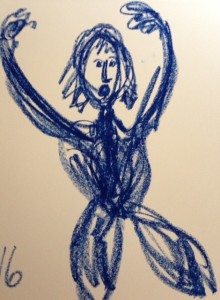Call it choking, call it the imposter syndrome, call it nervous energy… you know when you flub it. You know what it looks like and what it sounds like. You know when it’s likely to happen. And you know the consequences.
Job interviews, networking, public speaking, performance reviews, sales meetings… most of us flub when the stakes are high. We often diminish ourselves at the very times it’s important to be confident and assertive.
What can you do about the flub? First, stop beating yourself up for what you did or didn’t do.
Now, I’m going to make a suggestion that might surprise you.
Get familiar with the circumstances when you flub it! and notice specifically what goes through your mind and happens in your body, voice and nervous system!
Yes! If you want to shift your patterns then you have to pay close attention to what grabs you and takes you down a notch. No more being caught off-guard.
Because here’s the thing about flubbing it. It’s unconscious, it’s often habitual, and it takes us by surprise. The protective-what-if-they-see-me-will-they-like-me-what-if-they-reject-me voices have lots of power.
I’m using the word “flub” because I want you to treat yourself kindly. You botched it. Now dust yourself off, give yourself a hug and sit up straight.
Here’s my advice for un-flubbing: 1) get familiar with your flub patterns, 2) start practicing ways to shift hard-worn patterns of mind, body and voice, and 3) ask for feedback from others and tell them what to look and listen for.
Here are typical flub patterns:
Getting small: your voice gets quiet, you step back, you forget what you are going to say, you look down at the floor
Getting busy: you talk too much, you ramble on, you shift side to side, your hands and arm gestures are all over the place
Getting stiff: you stop breathing, your voice is monotone, you don’t move your body
Getting in someone’s face: you talk too loud, you puff up your chest, you step forward, you boast to boast
Which of these apply to you?
All of us have a tendency toward one of these patterns, although we may well dance from one to the next. Our body language and posture communicates are most hard-wired pattern; and we can move in and out of patterns depending on our socialization, culture, self-image and more.
If it sounds complicated, don’t be discouraged. The good news is that a small shift makes a huge difference. For example, you can choose to work on speaking more loudly and clearly, or standing with both feet planted firmly on the floor. Pair up a new body pattern with an intention of how you want to show up. Qualities like solid, calm, dignified, articulate can help you align body and mind.
A few more things:
Make sure you work on your verbal content. An important part of a strong delivery is knowing what you want to say.
Make sure you practice out loud and ideally in front of a kind audience. Developing new patterns and strengthening your impact takes practice practice practice and benefits from feedback, support and appreciation.
Make time to practice with your body and voice every day! Yes, it takes thousands of repetitions for a body pattern to become second nature. You’ve been practicing the flub patterns a long time. Wake your body up and get it in shape. Start with five minutes a day and build from there.
And, as always, join us at the Interview Club or at one of my upcoming workshops to get practice in community.